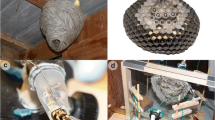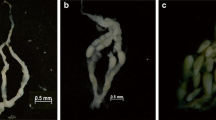Summary
-
1.
The post-winter growth of those larvae ofMyrmica rubra L. that yielded under optimal culture conditions, workers and intercastes, has been described with daily measurements of weight, wing and leg bud size, and the state of maturity, and observations on the development of the ovaries.
-
2.
Workers follow the queen method of growth and development for varying periods and then deviate through an increase in the rate of development relative to growth, or an inhibition of growth without full inhibition of development. In both cases, wing and probably ovary growth is more or less concomitantly slowed and stopped so that the emerging adult is imperfect.
-
3.
Intercastes follow the queen ontogeny type for longer than workers, and deviate in more varied ways. Their wing (and ovary) growth is not immediately inhibited. The ontogeny of a microgyne is described, and of some aberrnat males.
-
4.
The evidence indicates that intercastes are organically suppressed by changes in the growth rate/development rate relation that acts most severely on individuals that are intermediate in size and related characters at the start of the final period of development during which segmentation of the adult legs and ovaries takes place.
-
5.
Three factors favour queen formation: large hibernation stature, slow development rate, and high specific growth rate. The first of these is a compound of the second and third acting in the period prior to winter.
Résumé
-
1.
On a décrit la croissance post-hivernale des larves de laMyrmica rubra, destinées à devenir, dans des conditions de culture optima, des ouvrières et des intercastes; on a également donné des observations journalières relatives au poids, à la taille des embryons de pattes et d'ailes, à létat de maturité, et au développement des ovaires.
-
2.
La croissance et le développement des ouvrières sont parallèles à ceux de la reine pendant des périodes variables, puis divergent: la dévelopement s'accélère par rapport à la croissance; ou bien on assiste à une inhibition de la croissance sans qu'ait lieu l'inhibition totale du développement. Dans les deux cas, avec une concomitance relative, la croissance de l'aile et probablement celle de l'ovaire se ralentissent et cessent, de sorte que l'adulte est imparfait.
-
3.
Les intercastes suivent le type ontogénique de la reine plus longtemps que les ouvrières et divergent suivant des voies plus variées. La croissance de l'aile et de l'ovaire n'est pas immédiatement inhibée. On décrit l'ontogénie d'un microgyne et celle de certains mâles anormaux.
-
4.
Les observations recueillies montrent que les intercastes sont supprimées organiquement, par des modifications dans le rapport entre le rythme de la croissance et le rythme du développement, qui agissent avec la plus grande rigueur sur les individus intermédiaires par la taille et les caractères apparentés, au début de la période finale de développement, au cours de laquelle la segmentation des pattes adultes et des ovaires a leiu.
-
5.
Trois facteurs favorisent la formation de la reine: grande taille d'hibernation, lenteur du développement, et intensité de la croissance spécifique. Le premier facteur résulte de l'action combinée du second et du troisième dans la période qui précède l'hiver.
Выводы
-
1.
В статье дано описание роста в послезимний период личинок Myrmica rubra L., /муравья/, которые при опимальных условиях выращивания (в лаборатории) превратились в работников и в междукастовые формы. В описании приведены даннье ежедневных измерений роста, величны крыльев и зачатков ног, состояния зрелости, и наблюдения над развитием яичников.
-
2.
Работники вначале, втечение разнюх периодов, растут и развиваются тем же путем, что и матка (муравьиная царица), но затем уклоняются от него увеличением быстроты развития по сравнению с ростом, или задержкой в росте, без полной задержки в развитии. В обоих случаях это в большей или меньшей степени сопровоздается задержкой в росте крыльев и вероятно и яичников, так что получающаяся взрослая особь несовершенна.
-
3.
Междукастовые формы следуют типу антогенеза матки более продолжительный период, чем работники, и уклоняются от него разнообразнее. Рост их крыляев /и яичника/ не задерживается тотчас же. Дается описание антогенеза микрогины и некоторых аберрируущих самцов.
-
4.
Получены доказательства, указывающие на то, что межкастовые формы органически угнетаются изменениями во взаимоотношениях между скоростью роста и скоростью развития, что влияет осовенно резко но особей средних по величине и по другим признакам, связанным с величиной, вначале конечного периода развития, в течение которого происходит сегментация ног и яичников взрослых особей.
-
5.
Три фактора благоприятствют формированию матки: крупная величина тела в период зимовки, медленный темп развития и высокая относительная скорость роста. Первый фактор —слагаемое из второго и третьего, действующих в период, предшествуйщий зимовке.
Similar content being viewed by others
Références
1939.Bodenstein (D.). — Factors determining facet number inDrosophila (Genetics,24, 494–508).—Bodenstein (D.), 1953. Postembryonic Development,Insect Physiology, John Wiley, New York.
1954.Brian (M. V.). — Studies of caste differentiation inMyrmica rubra L. 1. The growth of queens and males. (Insectes Sociaux,1, 101–122).
1878.Dewitz (H.). — Beitrage zur postembryonalen Gliedmassensenbildung bei den Insecten. (Z. wiss. Zool.,30, 78–105).
1923.Ezhikov (1). — Ueber den Charakter der Variabilitat der Ameisen-Ovarien (Revue Zool. Russe,3).
1928.Gabritschevsky (E.) andBridges (C. B.). — The giant mutation in Drosophila melanogaster: 2, Physiological aspects of the giant race. (Z. induk. Abstamm.-u. Vererblehre,46, 248–284).
1947.Gœtsch (W.). — Der Einfluss von VitaminT auf Gestalt und auf Gewohnheiten von Insekten (Œsterr. Zool. Zeits.,1, 193–274).—Gœtsch (W.), 1948. Die Wirkung von Vitamin T bei Vertebraten (Œsterr. Zool. Zeit.,1, 533–626).
1940.Goldschmidt (R.). —The material basis of evolution, Yale Univ. Press, New Haven.
1941.Gordon (C.) andSang (J. H.). — Nutrition and the gene antennaless,Drosophila (Proc. R. Soc. London, B130, 151–184).
1953.Hall (D. W.) andSmith (I. C.). — Atypical forms of the wingless worker and the winged female inMonomorium pharaonis L. (Hymenoptera Formicidae) (Évolution,7, 127–135).
1943.Haydak (M. H.). — Larval food and development of castes in the honey-bee (J. Econ. Ent.,36, 778–792).
1902.Janet (C.). — Anatomie du gaster de laMyrmica rubra, Paris, Carré et Cie, 68 pages.
1940.Melampy (R. M.), Willis (E. R.) andMcGregor (S. E.). — Biochemical aspects of the differentiation of the female honey-bee (Apis mellifera L.) (Physiol. Zool.,13, 283–293).
1941.Mickey (G. H.) andMelampy (R. M.). — Cytological studies on fat cells in the larval honey-bee (Apis mellifera L.) (Anat. Rec.,81, suppl. 53).
1930.Œrte (E.). — Metamorphosis in the honey-bee (J. Morph. and Physiol.,50, 295–332).
1933.Rhein (W.). — Ueber die Entstehung der Weiblichen Dimorphismus im Bienenstaate (Z. Wiss. Biol.,129, 601–665).
1953.Wilson (E. O.). — The origin and evolution of polymorphism in ants. (Quart. Rev. Biol.,28, 136–156).
1916.Zander (E.). — Die Ausbildung des Geschlechtes bei der Honigbiene (Z. Angew. Ent.,3, 1–74).
1925.Zander (E.) andBecker (F.). — Die Ausbildung des Geschlechtes bei der Honigbiene (Erlangen Jahrbuck f. Bienenkunde,3, 161–246).
Author information
Authors and Affiliations
Additional information
Now of the Nature Conservancy, Furzebrook Research Station, Wareham, Dorset.
Rights and permissions
About this article
Cite this article
Brian, M.V. Studies of caste differentiation in «Myrmica Rubra» L. Ins. Soc 2, 1–34 (1955). https://doi.org/10.1007/BF02223434
Issue Date:
DOI: https://doi.org/10.1007/BF02223434




